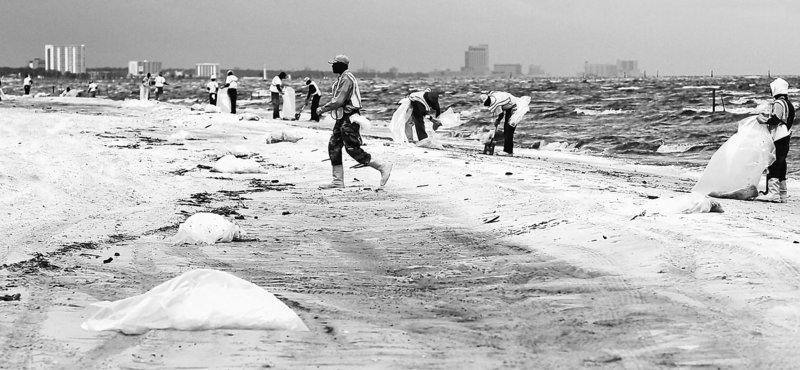GRAND ISLE, La. – The crashing waves and gusting winds churned up by Tropical Storm Alex put the Gulf oil spill largely in Mother Nature’s hands Tuesday. Regardless of whether the storm makes things worse or even better, it has turned many people fighting the spill into spectators.
Oil-scooping ships in the Gulf of Mexico steamed to safe refuge because of the rough seas, which likely will last for days. Officials scrambled to reposition boom to protect the coast and had to remove barges that had been blocking oil from reaching sensitive wetlands.
Alex is projected to stay far from the spill zone and is not expected to affect recovery efforts at the site of the blown-out well. But the storm’s outer edges complicated the cleanup as the oil turned whitecaps red.
Waves were as high as 12 feet in parts of the Gulf, according to the National Weather Service.
Coast Guard Lt. Dave French said skimming efforts had been halted off the Louisiana coast. Wayne Hebert, who helps manage skimming operations for BP PLC, said all nearshore skimmers were idled off the Florida, Alabama and Mississippi coasts.
“Everyone is in because of weather, whether it’s thunderstorms or (high) seas,” he said.
French said workers were using the time off the water to replenish supplies and perform maintenance work.
In Grand Isle, dozens of vessels, from skiffs up to huge shrimp boats, were tied up at the docks, rocked by waves even in the sheltered marina.
“It’s really rough out there,” said Coast Guardsman Zac Crawford. “We want the oil cleaned up, but we want people to be safe. “
Beach cleanup workers struggled with wind that blew sand into their eyes and humidity that let the sand stick to their skin.
Farther inland, local officials feared the weather could hamper efforts to keep the oil out of Lake Pontchartrain. The lake, connected to the Gulf by narrow passes, is a recreational haven for metropolitan New Orleans.
Authorities worried that underwater currents and an easterly wind might drive a 250-square-mile oil slick north of the Chandeleur Islands toward the lake.
“We’re very concerned because of the weather,” said Suzanne Parsons, spokeswoman for St. Tammany Parish, on the north side of the lake. “That means they can’t get out and start working it. This may be the first test of our outer lines of defense.”
Meanwhile, Jefferson Parish Council member Chris Roberts said the oil was entering passes Tuesday at Barataria Bay, home to diverse wildlife. A day earlier, barges that had been placed in the bay to block the oil were removed because of rough seas. Displaced boom had to be repositioned, he said in an e-mail.
The loss of skimming work, combined with 25-mph gusts driving water into the coast, has left beaches vulnerable. In Alabama, the normally white beaches were streaked with oil, and tar balls collected on the sand. One swath of beach 40 feet wide was stained brown and mottled with globs of oil matted together.
That nasty weather will likely linger in the Gulf through Thursday, National Weather Service meteorologist Brian LaMarre said.
Scientists have said the rough seas and winds could actually help break apart the oil and make it evaporate faster.
The wave action, combined with dispersants sprayed by the Coast Guard, have helped break a 6-by-30-mile oil patch into smaller patches, Coast Guard Cmdr. Joe Higgens said.
The storm, however, pushed the oil patch toward Grand Isle and uninhabited Elmer’s Island, dumping tar balls as big as apples on the beach.
“The sad thing is that it’s been about three weeks since we had any big oil come in here,” marine science technician Michael Malone.
Forecasters expected Alex to grow to hurricane strength later Tuesday over the southwestern Gulf, on track for the Texas-Mexico border region and away from the oil spill area off Louisiana.
So far, between 70.8 million and 137.6 million gallons of oil have spewed into the Gulf of Mexico from the broken BP well, according to government and BP estimates. The higher estimate is enough oil to fill half of New York’s Empire State Building with oil.
Hurricane warnings were posted for parts of the coast along Mexico and Texas. Most of the warning area is lightly populated.
Still in the Gulf are vessels being used to capture or burn oil and gas leaking from the well and to drill relief wells.
In Louisiana, the Coast Guard had to evacuate workers and equipment from coastal areas in Terrebonne Parish because of tidal surges that could cause flooding, French said.
All the uncertainty over what storms could do to BP’s containment effort gave new urgency to the company’s efforts to make its operations at the well as hurricane-resistant as possible.
The company said it hopes to install a new oil-capturing system by next week that would allow BP to disconnect the equipment faster if a hurricane threatens and hook it back up quickly after the storm passes.
The containment system now in place is capturing nearly 1 million gallons per day from the well, which is spewing up to 2.5 million gallons a day, according to the government’s worst-case estimate.
Send questions/comments to the editors.



Success. Please wait for the page to reload. If the page does not reload within 5 seconds, please refresh the page.
Enter your email and password to access comments.
Hi, to comment on stories you must . This profile is in addition to your subscription and website login.
Already have a commenting profile? .
Invalid username/password.
Please check your email to confirm and complete your registration.
Only subscribers are eligible to post comments. Please subscribe or login first for digital access. Here’s why.
Use the form below to reset your password. When you've submitted your account email, we will send an email with a reset code.